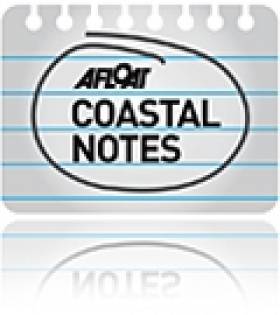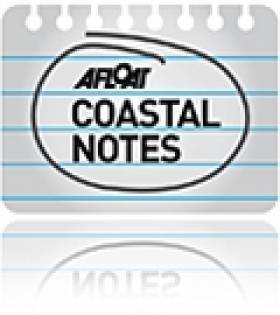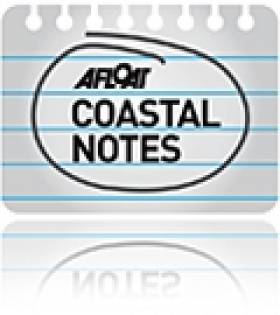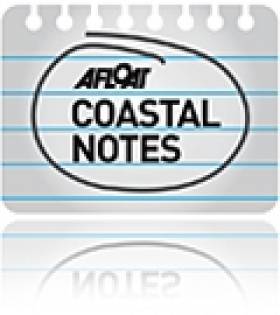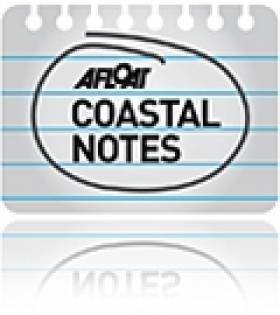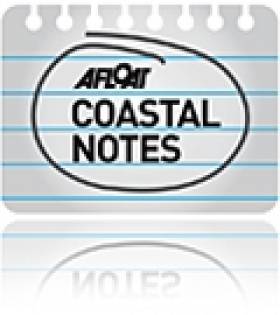Displaying items by tag: Coastal Notes
Maritime Museum Breaks Tradition with Monday Opening
#MUSEUM MONDAYS – Another national museum in Ireland has opened it doors to the public on Mondays, as is the case of the National Maritime Museum of Ireland in Dun Laoghaire, writes Jehan Ashmore.
The inaugural Monday opening took place at the end of last month and the extension of opening days continues at least throughout the summer months.
Only in June the museum was officially re-opened by President Michael D. Higgins. The musuem had been closed for several years due to essential renovation works costing €4m. A development programme was also implemented with funding from volunteers and government grants.
The premises of the museum are housed in the former Mariners Church on Haigh Terrace, which leads off Dun Laoghaire's main shopping thoroughfare on Georges Street. The museum is operated by the Maritime Institute of Ireland (M.I.I.) and has the invaluable support of a Community Employment Scheme of the Department of Social Protection.
With the new opening hours the museum is open seven days a week from 11am to 5pm. For further information on the M.I.I.'s museum and events visit: www.mariner.ie
Dún Laoghaire Seafront Memorials Tour
#SEAFRONT TOURS – With glorious weather hopefully holding, seize the opportunity by taking the sea-air and learn at the same time. Sounds like a good combination, so why not consider joining the Seafront Memorials Tour which is a guided tour in Dun Laoghaire Harbour running every Saturday morning until the 1 September.
The tours take in all the coastal memorials along the harbour's waterfront including the Queen Victoria Fountain, George IV Memorial, the mailboat R.M.S. Leinster's anchor, the Crimean War Cannon and the 1895 Lifeboat Disaster.
The tours start at 11.30 am (1 tour on each Saturday) and they take approximately 1 hour. The maximum number of people for each tour is 20 persons, noting the outdoor event is also wheelchair accessible. No pre-booking is required and places are limited so it is advisable to turn up early.
The tours are part of the 'Summer of Heritage' programme which is now in its fifth year organised by Dun Laoghaire-Rathdown County Council. For information call: (01) 254 2387 or visit: www.dlrevents.ie/heritage.html
Corrib Pipeline Tunnel Machine Removed from Mayo Road
#COASTAL NOTES - A tunnel boring machine destined for work on the Corrib Gas Field project that became stuck at a country crossroads in Co Mayo for much of last week has been removed, as The Irish Times reports.
Shell E&P Ireland apologised to the local community and any road users "who were inconvenienced by this incident" after the truck carrying the giant machine jack-knifed at the isolated road junction on Tuesday 31 July.
The truck was one of four headed to the Sruwaddacon estuary in north Mayo for construction work on what will be the longest raw gas undersea tunnel in Western Europe, used to link the Corrib pipeline to the on-shore refinery at Bellanaboy.
It was finally removed from the crossroads on Friday 3 August.
A spokesman for Rossport Solidarity Camp added that veteran anti-Corrib campaigner Maura Harrington was arrested at one of the Garda checkpoints around the stricken vehicle some 10km away at Bangor Erris.
As previously reported on Afloat.ie, the controversial gas field project has come under much criticism from locals, activist groups and political parties for various issues.
In March last year, former Minister for Energy Pat Carey was rebuked for granting key consents for the Corrib gas pipeline on the day of the general election, despite planning only being approved by An Bord Pleanala with 58 conditions related to the construction and management of the 8.3km pipeline.
Earlier this summer the Irish Whale and Dolphin Group (IWDG) claimed the Department of Energy could be in breach of the EU habitats directive for licencing a seismic survey related to the project without providing adequate protection for marine wildlife.
And in June a Scandinavian economist who met residents in north Mayo told The Irish Times that the Norwegian people have "no idea of what's being done in their name" via the role of state oil firm Statoil in the Corrib Gas Field.
Dún Laoghaire Seafront Memorials Tour
#SEAFRONT TOURS – Another weekend and a chance to take in the fresh sea-air while learning at the same time. Sounds like a good combination, so why not consider joining the Seafront Memorials Tour which is a guided tour in Dun Laoghaire Harbour which runs every Saturday morning until the 1 September.
The tours take in all the coastal memorials along the harbour's waterfront including the Queen Victoria Fountain, George IV Memorial, the mailboat R.M.S. Leinster's anchor, the Crimean War Cannon and the 1895 Lifeboat Disaster.
The tours start at 11.30 am (1 tour on each Saturday) and they take approximately 1 hour. The maximum number of people for each tour is 20 persons, noting the outdoor event is also wheelchair accessible. No pre-booking is required and places are limited so it is advisable to turn up early.
The tours are part of the 'Summer of Heritage' programme which is now in its fifth year organised by Dun Laoghaire-Rathdown County Council. For information call: (01) 254 2387 or visit: www.dlrevents.ie/heritage.html
#COASTAL NOTES - Providence Resourses has announced that its Barryroe oil field off the south coast may be as much as four times larger than anticipated, according to The Irish Times.
Afloat.ie previously reported on the Irish mineral exploration group's discovery in April this year, when the company confirmed the presence of light oil with an appraisal well at the site in the north Celic Sea.
Then on 15 March the firm announced that oil had begun to flow successfully from the Barryroe structure at a rate that could be worth billions of euro to the Irish economy.
The latest news suggests it could be worth even more over a longer period of time, as data compiled from six test wells on the site along with seismic data have led experts to estimate the field contains between 1 and 1.6 billion barrels of oil.
“It is clear that Barryroe is a substantial oil accumulation across multiple stacked horizons with much running room for further resource growth," said Providence chief executive Tony O'Reilly Jr.
The company also expects to begin explorations off Dalkey Island in Co Dublin by the end of the year, pending approval of its foreshore permit.
The so-called 'Dalkey Island prospect' has sparked much debate about its potential risks and benefits among the local community.
Dún Laoghaire Seafront Memorials Tour
#SEAFRONT TOUR – Having started last month, the Seafront Memorials Tour which is a guided tour in Dun Laoghaire Harbour will continue every Saturday morning until the 1 September.
The tours take in all the coastal memorials along the harbour's waterfront including the Queen Victoria Fountain, George IV Memorial, the mailboat R.M.S. Leinster's anchor, the Crimean War Cannon and the 1895 Lifeboat Disaster.
The tours start at 11.30 am (1 tour on each Saturday) and they take approximately 1 hour. The maximum number of people for each tour is 20 persons, noting the outdoor event is also wheelchair accessible. No pre-booking is required and places are limited so it is advisable to turn up early.
The tours are part of the 'Summer of Heritage' programme which is now in its fifth year organised by Dun Laoghaire-Rathdown County Council. For information call: (01) 254 2387 or visit www.dlrevents.ie/events.html
Swimming Ban at Clare Beaches Over E-coli Fears
#COASTAL NOTES - Surfers in Co Clare have been dealt a blow as the The Irish Times reports on a swimming ban at Lahinch and two other beaches over concerns of a potential outbreak of E-coli.
The beaches at Lahinch, Kilkee and Spanish Point ae covered by the ban, which was made by Clare County Council in consultation with the Health Service Executive after traces of E-coli were found in routine quality tests of the water.
Water runoff as a result of the recent heavy rainfall over the last few weeks has been blamed for the rise in bacteria levels, which has also seen Lahinch and Kilkee have their Blue Flag status suspended until they can meet the required quality standards.
The Irish Times has more on the story HERE.
NI Waters Under Threat by Pollution and Overfishing
#COASTAL NOTES - The Belfast Telegraph this week is running a special series investigating the environmental destruction of Northern Ireland's coastal and inland waters.
As the Telegraph's Linda Stewart writes: "Northern Ireland’s once rich seas are in danger of turning into dead zones devoid of marine life."
The 'Save Our Seas' series aims to "uncover the shocking evidence of how our treasured marine and aquatic environments have been decimated by years of neglect and failure to curb over-exploitation."
Already it's been reported that Stormont faces a whopping €9.6 million fine from the EU over its failure to protect horse mussel reefs in Strangford Lough.
But according to the Telegraph, that is just one of a number of "disturbing" happenings beneath the waves, with diver Barbara Irvine reporting shocking amounts of human waste littering the sea bed.
Meanwhile, anglers are quitting the shoreline as once plentiful supplies of fish have simply vanished.
“I no longer shore fish as there is no point, there’s nothing there," says Gary Gregg of the Irish Federation of Sea Anglers.
“We’ve been blessed with a very good mixed fishery due to the confluence of the oceans coming together with cold and warm water, but we've taken too much.”
The series continues in the Belfast Telegraph all this week.
New Giant's Causeway Visitors Centre Opens
#GIANT'S CAUSEWAY - The new Giant's Causeway visitors centre has opened to the public in Co Antrim in what's expected to be a big boost to tourism in the area.
Located close to the UNESCO World Heritage Site, the £18.5 million (€23 million) facility was designed to complement the coastal region's dramatic vistas, with a grass roof that allows it to blend in with the surrounding landscape, and columns that echo the causeway's thousands of naturally formed hexagonal basalt pillars.
As The Irish Times reports, the centre illustrates the story of the stones and the legend of Finn McCool and his Scottish rival who are said to have created the causeway during a mythical battle.
Already and award-winner for innovative design and sustainable features, the National Trust centre - located nine miles from Portrush - looks to welcome up to 780,000 visitors a year.
The Daily Telegraph has images of the new visitors centre and more on the story HERE.
Irish Sea Level to Rise Almost 50cm by 2099
#COASTAL NOTES - It's an alarming figure by any means - new research shows that the level of the Irish Sea will rise by almost half a metre by the end of the century, leading to much more severe flooding along the east coast and elsewhere.
The results of research published by the Ryan Institute at NUI Galway, as reported by The Irish Times, show that sea level rises of up to 47cm are not out of the question.
They also indicate that sea surface temperatures will increase by nearly 2 degrees, which would have serious implications for marine wildlife and the fishing industry.
Dr Mike Hartnett of the Tyan Institute said the new research - from 3D model-based projections of the seas around Ireland - is the most comprehensive study of its kind, and confirms previous "tentative" studies in the area.
The news comes after national weather forecaster Met Éireann announced an incredible 0.75 degree rise in average temperature in Ireland - and a 5% increase in rainfall - over the past two decades alone.
And with recent flooding in Cork and Belfast causing millions of euro worth of damage, the real implications of such figures is coming closer to home.
The Irish Times has more on the story HERE.


























